Site
created 12/15/97. |


page
added: 12/8/07
updated: 12/12/07
Blade
Runner: The Final Cut - All Versions
1982/1992/2007
(2007) - The Blade Runner Partnership (Warner Bros.)
Disc
reviews by Bill Hunt of The Digital Bits
  
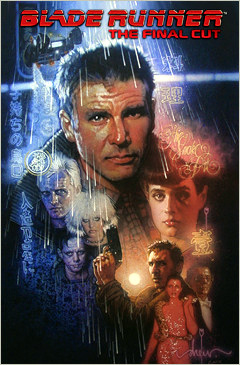
|
I'll
tell you... we've been waiting for this moment for a long time
here at The Digital Bits.
A long time.
As you might guess, we're all big fans of Ridley Scott's Blade
Runner around here. The first copy of the film I ever
owned on video was the laserdisc release from Criterion back in
1987, which featured the 1982
International Cut of the film. I still prize that
disc to this day. Years later, in March of 1997, the very first
DVD I ever purchased - even before I'd gotten my hands on an
actual DVD player - was Warner's original release of Blade
Runner: The Director's Cut. In retrospect, it was a
terrible disc, with no features and mediocre (by today's
standards) quality. But damn it... it was Blade
Runner and there it was on my favorite new format,
looking way better than my laserdisc. At the time, for me, it
was the Best Thing Ever.
As the years passed, however, that disc's flaws became all too
apparent. And as film after film was turned into elaborate DVD
special editions, the question of Blade
Runner's re-release status continued to grow in the
minds of fans.
|
|
Back
in 2000, an effort was mounted to produce a TRUE director's cut of
the film, and to give it the in-depth treatment fans wanted. Work
was begun at that stage, but a variety of business and legal
obstacles prevented the project from gaining momentum. Eventually,
however, the Blade Runner Partnership and Warner Bros. were able to
come to an agreement, clearing the way for the effort to move ahead,
just in time to celebrate the film's 25th anniversary in 2007. The
result is Blade Runner: The Final Cut,
available on DVD, Blu-ray Disc and HD-DVD from Warner Home Video on
December 18th. I'm pleased now to offer you all my ultimate,
in-depth review of this release. There are no less than seven
versions of The Final Cut
available on disc (three on DVD and four in high-definition), so
we're going to look at all of the content available on the most
elaborate versions, the Five-Disc
Ultimate Collector's Editions, disc by disc. At the end
of this review, you'll find cover art for all the different
versions, along with a list of content available in each, to help
you choose the one that's right for you.
The Film
It's easy to understate Blade Runner's
impact on the films that followed it, particularly in the genre of
science fiction. Based on an eclectic and complex novel by Philip K.
Dick (Do Androids Dream of Electric
Sheep?), Blade Runner
is as much a hard-boiled film noir detective story as it is science
fiction. And yet on the latter score, the film's high-concept
premise ranks easily alongside such cinematic landmarks of the genre
as Stanley Kubrick's 2001 and
Forbidden Planet. All you need
to do is watch almost ANY of the classic works of Japanese anime (Akira,
Ghost in the Shell, Patlabor)
and you'll see Blade Runner's
influence in nearly every frame.
Set in a gritty, run-down Los Angeles of the near future, Blade
Runner follows the efforts of a somewhat reluctant police
detective named Deckard (played by a young Harrison Ford, who was
just coming into his own as an actor, fresh off the experience of
making The Empire Strikes Back
and Raiders of the Lost Ark).
Deckard's job is to "retire" (read: kill) rogue, synthetic
humans called Replicants. These Replicants are made to do Mankind's
dirty work, acting as soldiers, laborers and sex servants, and
they're given implanted human emotions and memories to make them
seem more realistic. But those emotions eventually become
troublesome as, over time, the Replicants begin to develop real
consciousness and identities of their own. For this reason, they're
also given limited, four-year life spans before they simply
deactivate. But when they become aware of their own "mortality,"
some Replicants grow desperate, choosing to run and hide in the
shadows of society, in the vain hope of saving themselves... or at
least understanding the meaning of their brief existence. When they
do, it's Deckard's job to find and destroy them before they hurt the
humans around them.
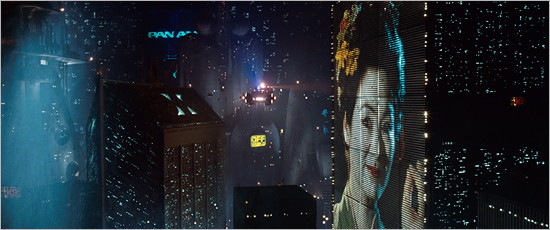
In addition to Ford's steady on-screen presence, Blade
Runner features great, seminal performances by the likes
of Rutger Hauer, Edward James Olmos, Sean Young and Daryl Hannah,
not to mention a host of fantastic character actors. The film's
production design was overseen by legendary futurist Syd Mead,
giving it a highly unique visual style never-before-seen on the big
screen. The film also includes a sparse but evocative score by
composer Vangelis (more commercially known for his work on Chariots
of Fire). But it's the efforts of director Ridley Scott
for which this film is perhaps best known.
If The Duellists was the film
that first garnered Scott critical notice, and it was Alien
that brought him to the attention of a much wider audience... Blade
Runner is the film that solidified his acclaim among
hard-core cinephiles and earned him a loyal legion of fans. Scott's
near manic attention to detail and his use of rich, stylish and
atmospheric staging and camera setups were on full, unrestrained
display here - a fact that caused significant problems with his
producers and the studio at the time. Surprisingly, when the film
was released into theaters, it was a critical and commercial bomb.
Many people just didn't know what to make of it. Over the years,
however, opinions have shifted dramatically. Blade
Runner is, today, considered one of the best films (if
not THE best) in Scott's decidedly impressive body of work. It
showcases Ridley at his most... well, Ridley. Even at the time of
its original release back in 1982, Blade
Runner quickly and definitively set its director apart
from other filmmakers as a singular, visionary talent.
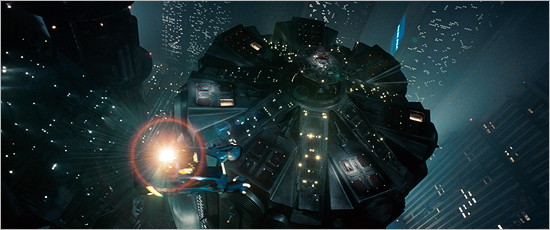
Disc One - The Final Cut (2007)
Film Rating: A+
Video/Audio Ratings (DVD): A/A
Video/Audio Ratings (Blu-ray Disc 1-20): 19/19.5
Video/Audio Ratings (HD-DVD 1-20): Coming Soon
Bonus Material: A
In the years since Blade Runner
first dazzled and puzzled audiences around the world, a number of
different versions of the film have surfaced. There's the original
theatrical cut, the international cut, the much sought-after (and
seldom seen) "workprint," and a 1992 director's cut that
wasn't actually a director's cut. It's only now in 2007 however,
some 25 years after the film's debut, that fans of Blade
Runner finally have the chance to see it as its director
intended.
An incredible wealth of vintage production material was unearthed
from the vaults for this release, including some 977 cans of
original film negative. Much of this footage was scanned at 4K
resolution (some of the 65mm effects footage was even scanned at 8K)
and an extensive restoration was done. Throughout this process,
restoration producer Charles de Lauzirika worked closely with Warner
Bros. and Ridley Scott to assemble the director's ultimate version
of the film, billed as The Final Cut.
The running time of The Final Cut
is 117 minutes - virtually identical to the original theatrical
release, but there have been many changes, most of them quite
subtle. First, the film has undergone a painstaking frame-by-frame
digital clean-up to remove unwanted dust, scratches and other
age-related image defects. The film has been color-timed to Scott's
specifications, and its soundtrack has been remastered as well to
take advantage of the latest surround sound technology (so when
those Spinners fly by now, you'll really hear them zoom past you and
away).
As you'd expect, the film's editing has been massaged here and
there, but this time to Scott's exact instructions. Like the 1992
version, this new Final Cut
omits the Deckard narration and the happy ending. Scott has made
subtle trims here and there to tighten the footage (without the
narration, he felt that some shots went on a little too long), but
he's also added material. For example, the "unicorn" scene
is now a bit longer and more effective (it's actually the
originally-intended version, the complete footage for which couldn't
be found for use in the '92 cut). Footage from both the
international and workprint versions has been inserted into the film
as well, including a number of street/atmosphere shots (such as the
infamous hockey-masked geisha dancers) and more intense moments of
violence.
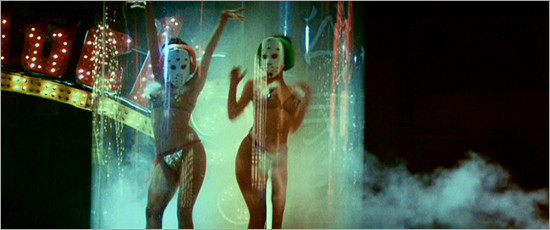
Scores of subtle digital tweaks have also been made to correct
problems that couldn't be addressed during the original production.
For example, the wires supporting the practical, on-set Spinner
vehicles have been removed. In a couple of street shots, members of
the production crew accidentally appeared in the edges of the frame
- they're gone now. Various matte lines have been erased, and detail
that was lost due to image degradation has been restored. When you
see the infamous "eye" shot at the beginning of the film,
the optical printing process employed at the time wouldn't allow for
a moving image of the eye to be used. So now, in The
Final Cut, you'll notice the pupil iris slightly in
reaction to the plume of fire billowing before it.
Other digital corrections fix continuity errors. In the original
shooting script, Leon and Deckard fought in the street before Zhora
was "retired," so the make-up reflected this on set. When
the film was edited together, however, Leon and Deckard's fight was
moved after Zhora's death. But the bruise on Deckard's face was
still there, before the fight actually happened on screen, so it's
been erased digitally. In another instance, the first time you see
Roy Batty on screen in the sidewalk Vid-Phon booth, the shots were
actually stolen from later in the film (a moment of Roy at the
Tyrell Corporation, I believe, and a shot of him in the Bradbury
building). So the lighting and the backgrounds you saw in those
shots didn't match the booth or the rain-soaked streets behind it.
Now they do. There's also a scene where Deckard is talking to an old
Asian woman about the snake scale he's found. She's reading a serial
number from a microscope... but when you saw that serial number on
the screen, it didn't match. Now it does. The vast majority of these
digital effects tweaks are so subtle that only fans who are
intimately familiar with the film will even notice them.
On the other hand, a few of the digital fixes correct more serious
problems with the film in its previous incarnations. For example,
when Roy releases the dove at the end of the film, the skyline
revealed as it flies away just didn't match anything you'd seen
before. So a new digital cityscape was created for the shot that
finally does match.
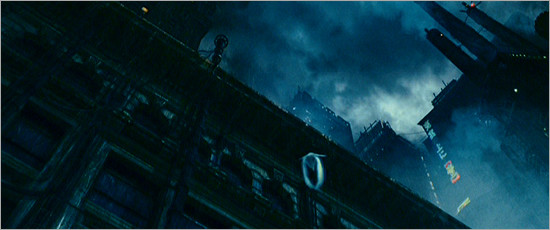
There's also a scene when Deckard is talking to the snake dealer,
Abdul Ben-Hassan, in which his lip movements didn't match the
dialogue. Harrison Ford was unavailable due to scheduling issues, so
his son Ben was brought in correct this. Ben was shot on an effects
stage from exactly the same angle, wearing exactly the same chin
scar (via make-up) that his father has, saying the correct lines.
His mouth was digitally inserted over his father's seamlessly.
Of course, many of you know of the infamous reshoot from earlier
this year, featuring the character Zhora. When news of this leaked
on the Net, it sparked an outcry from fans who feared that Scott was
drastically altering the film with all new scenes. It turns out,
nothing could be further from the truth. Back in 1982, actress
Joanna Cassidy wasn't allowed to do the stunt where Zhora crashes
through the window panes. But if you watch the film closely,
especially now in high-definition, it's painfully obvious that it's
a stuntwoman in those shots. So Cassidy was brought back in, dressed
in her original costume, and was shot on a greenscreen stage, going
through the same movements as the stuntwoman. Her face and body
angles were matched to those of the stuntwoman's frame by frame.
Cassidy's head was then digitally inserted over the stuntwoman's,
and the resulting image was blended, color-corrected and matched
seamlessly. So now, when you see Zhora crash through the glass, it's
actually Zhora all the way through. The result is amazing. The first
time I saw the finished sequence several months ago, I was actively
looking for the effect and I completely missed it. It's only when
you re-watch the original scene on DVD that you appreciate how
startling the difference is... and just how good the new effects
shots actually are.
Here's a comparison: This is how the Zhora sequence appeared in the
original version of the film...
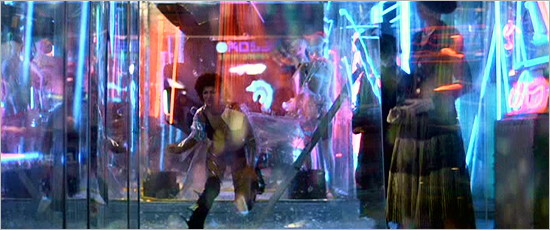
Now, here's the new digital effects shot from The
Final Cut...
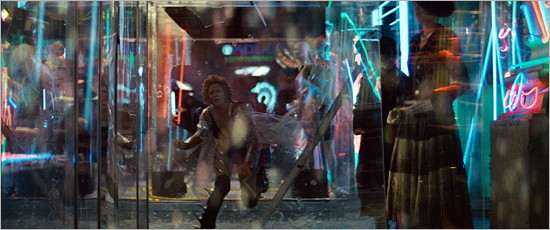
Ultimately, when you see The Final Cut
for yourself, I think you'll appreciate the tremendous and
pain-staking effort that's been made to smooth out the rough edges
in Ridley Scott's original film. I'll tell you, I find it
extraordinary after all these years to still have the chance to
discover so much that's new in this film. If you love Blade
Runner like I do, this new version is a treat.
The DVD versions of The Final Cut
present the film in outstanding anamorphic widescreen video quality,
mastered from the original high-definition transfer. The colors are
rich and vibrant, with exceptional clarity and texture throughout.
Contrast is excellent as well, with deeply defined shadows, while
still retaining plenty of detail in the darkest areas of the image.
The new Dolby Digital 5.1 surround presentation (in English and
French) features an expansively wide soundstage and smooth,
atmospheric imaging. There's frequent but subtle use of the rear
channels for effects, and Vangelis's score is beautifully layered in
the mix - it just envelopes you in mood and emotion. LFE
reinforcement is substantial, finishing out the soundscape nicely.
Subtitles are available in English (for the hearing impaired),
French and Spanish. This is certainly as good as Blade
Runner has ever looked and sounded on DVD and, quite
frankly, it's one of the best looking live-action DVDs I've seen in
a while.
As good as the DVD is, however, high-definition is definitely the
way to go if the option is available to you. The
Final Cut is available in both the Blu-ray Disc and
HD-DVD formats. Each has been mastered from the same encode, so the
video presentations should be identical.
We've got the Blu-ray Disc edition, and I can tell you that the
video quality is, in a word, spectacular. Contrast is superb, with
deep, detailed blacks. Colors are lush and accurate. There's very
light to moderate grain visible, with breathtaking clarity, texture
and detail. You can see how the effects footage benefitted from 6K
scanning - these shots have just simply never looked better. Best of
all, there isn't a speck or scratch to be seen anywhere. The Dolby
TrueHD audio is also a significant improvement over the already
great DVD sound. The soundfield is smooth and wide, and the score
just sounds stunning in high-resolution. The low-end here will
rattle your windows if you're not careful. What a treat!
Whichever version you choose, Disc One offers no less than three
excellent, full-length audio commentary tracks. The first features
director Ridley Scott himself, as he discusses the idea behind many
of the different scenes, the symbolism, things he was trying to
convey, the differences between the various versions of the film.
There's plenty here about the production but better still there's
lots related to the story and concepts as well. It's a great track.
I should note here that this disc also features an optional video
introduction to The Final Cut
by Scott, which you can select from the main menu. The DVD menus
themselves are animated with sounds effects, and are designed to
look like Deckard's photo-analysis machine. Occasionally, as you
wait, a bit of the Vangelis score will play for atmosphere. The
menus are tasteful - nice without hitting you over the head. The
high-def versions feature the usual pop-up menus allowing you to
select the various options. There are 36 chapters.
The second commentary track features co-screenwriters Hampton
Fancher (also an executive producer) and David Peoples, along with
producer Michael Deeley and production executive Katherine Haber.
This is a really fascinating track. The combination of Fancher and
Peoples is fun to listen to, but they're an eclectic pair. The
obviously discuss substantial elements of story and script, which is
a treat to listen to. Deeley and Haber focus much more on the
mechanics and business sides of the production effort, as you might
expect. They're interesting to listen to, but the writers are
better.
The final commentary includes legendary futurist Syd Mead,
production designer Lawrence G. Paull, art director David L. Snyder
and special effects supervisors Douglas Trumbull, Richard Yuricich
and David Dryer. This is a great track for diehard fans -
particularly those who are interested in the nitty-gritty design and
technical aspects of the film. They obviously get deep into the
creation of the effects, the miniatures, the props and the physical
world of the film. They also comments on the new effects work as
well, which is fun to hear, as these guys were actually involved
and/or hand input in the new effects process.
So that's Disc One, but that's just scratching the surface of all
the material available in these new sets. Next, let's take a look at
Discs Two and Three... |
On
to Discs Two & Three |

|









